Shockable rhythms - Study guides, Class notes & Summaries
Looking for the best study guides, study notes and summaries about Shockable rhythms? On this page you'll find 457 study documents about Shockable rhythms.
All 457 results
Sort by
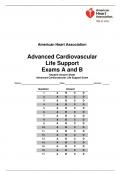 Popular
Popular
-
Advanced Cardiovascular Life Support (ACLS) Exams A and B 2023 A+
- Exam (elaborations) • 65 pages • 2024
-
- $13.49
- 9x sold
- + learn more
Advanced Cardiovascular Life Support (ACLS) Exams A and B 2023 A+ l Please do not mark on this exam. Record the best answer on the separate answer sheet. 1. Which type of atrioventricular block best describes this rhythm? A. First-degree B. Second-degree type I C. Second-degree type II D. Third-degree 2. Your patient is in cardiac arrest and has been intubated. To assess CPR quality, which should you do? A. Monitor the patient’s PETCO2 B. Obtain a 12-lead ECG C. Chec...
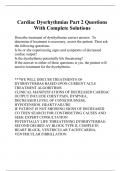 Popular
Popular
-
Cardiac Dysrhythmias Part 2 Questions With Complete Solutions
- Exam (elaborations) • 24 pages • 2023 Popular
-
Available in package deal
-
- $10.99
- 1x sold
- + learn more
Describe treatment of dysrhythmias correct answer: To determine if treatment is necessary, assess the patient. Then ask the following questions: Is he or she experiencing signs and symptoms of decreased cardiac output? Is the dysrhythmia potentially life threatening? If the answer to either of these questions is yes, the patient will need to treatment for the dysrhythmia. ***WE WILL DISCUSS TREATMENTS OF DYSRHYTHMIAS BASED UPON CURRENT ACLS TREATMENT ALGORITHMS CLINICAL MANIFESTATIONS ...
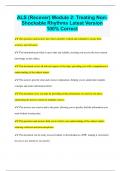
-
ALS (Recover) Module 2: Treating Non- Shockable Rhythms Latest Version 100% Correct
- Exam (elaborations) • 25 pages • 2024
-
Available in package deal
-
- $10.33
- + learn more
Treating Non-Shockable Rhythms The non-shockable rhythms (asystole and pulseless electrical activity) are the most common primary arrest rhythms in dogs and cats. In Module 2, we will discuss diagnosing the arrest rhythm using ECG analysis, and how that rhythm diagnosis guides ALS therapy. We will also discuss vasopressor therapy as a mainstay of treatment, as well as parasympatholytic drugs and additional therapies for prolonged asystole and prolonged PEA. ECG Interpretation: ECG analysis ...
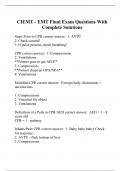
-
CIEMT - EMT Final Exam Questions With Complete Solutions
- Exam (elaborations) • 41 pages • 2023
-
Available in package deal
-
- $15.99
- 1x sold
- + learn more
Steps Prior to CPR correct answer: 1. AVPU 2. Check carotid! 3. If pulse present, check breathing! CPR correct answer: 1. Compressions 2. Ventilations **Partner goes to get AED** 3. Compression **Partner drops an OPA/NPA** 4. Ventilations Modified CPR correct answer: Foreign body obstruction + unconscious 1. Compressions 2. Visualize for object 3. Ventilations Definition of a Peds in CPR/AED correct answer: AED = 1 - 8 years old CPR = 1 - puberty Infants/Peds CPR c...
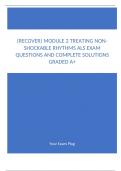
-
(Recover) Module 2 Treating Non-Shockable Rhythms ALS Exam Questions and Complete Solutions Graded A+
- Exam (elaborations) • 14 pages • 2024
- Available in package deal
-
- $13.49
- + learn more
(Recover) Module 2 Treating Non-Shockable Rhythms ALS Exam Questions and Complete Solutions Graded A+
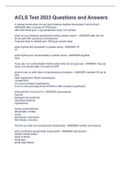
-
ACLS Test 2023 Questions and Answers
- Exam (elaborations) • 14 pages • 2023
-
Available in package deal
-
- $9.99
- 1x sold
- + learn more
ACLS Test 2023 Questions and Answers in cardiac arrest when do you first introduce medical intervention? which drug? - ANSWER after 2 rounds of CPR/shock after 2nd shock give 1 mg epinephrine every 3-5 minutes when do you introduce amiodarone during cardiac arrest? - ANSWER after the 3rd shock give 300 mg bolus of amiodarone if second dose is needed give 150mg as second dose what rhythms are shockable in cardiac arrest - ANSWER VF VT what rhythms are not shockable in cardiac arres...
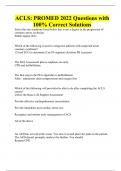
-
ACLS: PROMED 2022 Questions with 100% Correct Solutions
- Exam (elaborations) • 9 pages • 2023
-
Available in package deal
-
- $12.99
- 2x sold
- + learn more
Select the one syndrome listed below that is not a degree in the progression of coronary artery occlusion. Stable angina (SA) Which of the following is used to categorize patients with suspected acute coronary syndrome? 12-lead ECG to determine if an ST-segment elevation MI is present The BLS Assessment places emphasis on early: CPR and defibrillation The first step in the PEA algorithm is defibrillation. False - administer chest compressions and oxygen first Which of the...
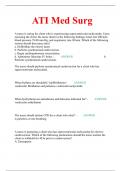
-
ATI Med Surg
- Exam (elaborations) • 49 pages • 2024
- Available in package deal
-
- $11.49
- + learn more
ATI Med Surg A nurse is caring for client who is experiencing supraventricular tachycardia. Upon assessing the client, the nurse observes the following findings: heart rate 200/min, blood pressure 78/40 mm Hg, and respiratory rate 30/min. Which of the following actions should then nurse take? a. Defibrillate the client's heart. b. Perform synchronized cardioversion. c. Begin cardiopulmonary resuscitation. d. Administer lidocaine IV bolus. - ANSWER ...
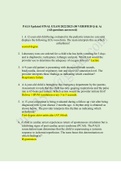
-
PALS FINAL EXAM 2024 (Actual Exam) (50 VERIFIED Q & A)
- Exam (elaborations) • 9 pages • 2022
-
Available in package deal
-
- $15.49
- 32x sold
- + learn more
PALS Updated FINAL EXAM 2022/2023 (50 VERIFIED Q & A) (All questions answered) 1. A 12-year-old child being evaluated in the pediatric intensive care unit displays the following ECG waveform. The team interprets this as which arrhythmia? second degree 2. Laboratory tests are ordered for a child who has been vomiting for 3 days and is diaphoretic, tachypneic, lethargic and pale. Which test would the provider use to determine the adequacy of oxygen delivery? Lactate 3. A 9-year-old...

-
ACLS MUST KNOW Updated 2024/2024 Revisions| Questions and Answers 100% Solved Grade A+
- Exam (elaborations) • 20 pages • 2024
- Available in package deal
-
- $15.99
- + learn more
ACLS MUST KNOW Updated 2024/2024 Revisions| Questions and Answers 100% Solved Grade A+ What is the recommended compression depth for adults and children? 2 inches What is the recommended compression depth for infants? 1 1/2 inches What can result if a patient is ventilated too quickly? hyperventilation -> excessive intrathoracic pressure and gastric inflation -> decreased venous return -> decreased coronary and cerebral perfusion pressures -> diminished cardiac output -&...

How much did you already spend on Stuvia? Imagine there are plenty more of you out there paying for study notes, but this time YOU are the seller. Ka-ching! Discover all about earning on Stuvia


